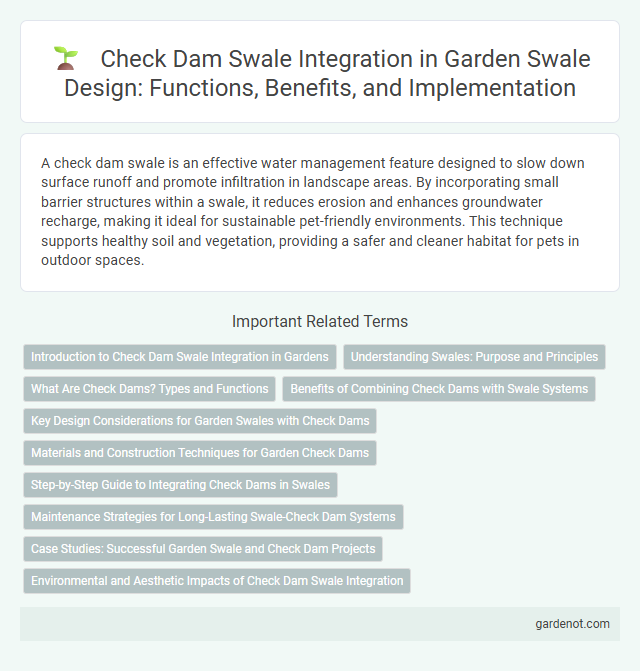A check dam swale is an effective water management feature designed to slow down surface runoff and promote infiltration in landscape areas. By incorporating small barrier structures within a swale, it reduces erosion and enhances groundwater recharge, making it ideal for sustainable pet-friendly environments. This technique supports healthy soil and vegetation, providing a safer and cleaner habitat for pets in outdoor spaces.
Introduction to Check Dam Swale Integration in Gardens
Check dam swale integration in gardens enhances water management by slowing runoff and promoting groundwater recharge. These structures capture sediment and reduce erosion, improving soil stability and nutrient retention for healthier plant growth. Incorporating check dam swales supports sustainable landscape design, balancing water flow and ecosystem resilience.
Understanding Swales: Purpose and Principles
Check dam swales are engineered landscape features designed to slow water runoff and enhance groundwater recharge by intercepting flow within swales. These structures reduce erosion and promote sediment deposition, improving soil stability and water quality in drainage areas. Key principles include strategic placement, appropriate sizing, and incorporation of vegetation to maximize infiltration and ecological benefits.
What Are Check Dams? Types and Functions
Check dams are small, often temporary barriers constructed across swales to slow water flow and reduce soil erosion. Common types include earthen, rock, and log check dams, each designed to accommodate specific site conditions and rainfall patterns. Their primary functions involve sediment capture, groundwater recharge, and promoting vegetation establishment within the swale system.
Benefits of Combining Check Dams with Swale Systems
Combining check dams with swale systems significantly enhances water retention by slowing runoff, promoting deeper infiltration and reducing soil erosion in catchment areas. This integration supports improved groundwater recharge and stabilizes slopes, which benefits agricultural productivity and mitigates flood risks. The synergy of check dams and swales creates sustainable landscape management solutions by maintaining moisture balance and preventing sediment loss.
Key Design Considerations for Garden Swales with Check Dams
Key design considerations for garden swales with check dams include proper spacing of dams to slow water flow, ensuring soil permeability to promote infiltration, and selecting durable materials that withstand erosion. The check dams typically range from 6 to 12 inches in height to maintain water levels while enabling gradual percolation. Adequate vegetation alongside swales stabilizes soil and enhances water retention, optimizing the overall stormwater management efficiency.
Materials and Construction Techniques for Garden Check Dams
Check dam swales utilize locally sourced materials such as rocks, stones, gravel, and logs to effectively slow water flow and enhance soil infiltration in garden landscapes. Construction techniques involve strategically placing these materials across natural swales at gentle intervals, ensuring stability with compacted soil or biodegradable geotextiles to prevent erosion. Proper alignment and maintenance of the check dam swales optimize water retention, support plant growth, and reduce runoff in sustainable garden designs.
Step-by-Step Guide to Integrating Check Dams in Swales
Integrating check dams in swales involves selecting appropriate materials like rocks or logs to slow water flow and enhance sediment capture within the swale channel. Begin by identifying strategic locations along the swale where runoff velocity is highest and erosion potential is significant, then install the check dams at intervals to create a stepped water flow system. Regular maintenance, including debris removal and structural inspection, ensures the longevity and effectiveness of the check dam swale system in managing stormwater and promoting groundwater recharge.
Maintenance Strategies for Long-Lasting Swale-Check Dam Systems
Effective maintenance strategies for check dam swales include regular sediment removal to prevent blockage and ensure optimal water flow, periodic inspection for structural integrity to detect erosion or damage early, and vegetation management to maintain soil stability and reduce sediment accumulation. Implementing a scheduled monitoring program enhances the longevity of swale-check dam systems by addressing potential issues proactively. Utilizing durable materials during construction also contributes to reduced maintenance frequency and improved system resilience.
Case Studies: Successful Garden Swale and Check Dam Projects
Check dam swales effectively manage stormwater runoff by reducing erosion and enhancing groundwater recharge in urban and agricultural landscapes. Case studies such as the Greenfield Community Garden show how integrated check dams improved soil moisture retention by 30%, fostering healthier plant growth and reducing irrigation needs. Similarly, the Riverside Park project demonstrated a 40% decrease in peak flow rates, highlighting the efficacy of combined swale and check dam systems in flood mitigation.
Environmental and Aesthetic Impacts of Check Dam Swale Integration
Check dam swale integration enhances soil erosion control by slowing water flow and increasing infiltration, promoting groundwater recharge and reducing sediment transport downstream. Vegetated swales combined with check dams support diverse plant growth, improving habitat quality and contributing to local biodiversity. The natural appearance of check dam swales blends well into landscapes, offering aesthetic benefits while supporting sustainable stormwater management.
Check dam swale Infographic

 gardenot.com
gardenot.com